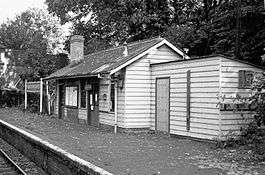Charlton Kings railway station
| Charlton Kings | |
|---|---|
|
June 1962 | |
| Location | |
| Place | Charlton Kings |
| Area | Cheltenham |
| Coordinates | 51°52′33″N 2°03′17″W / 51.8759°N 2.0548°WCoordinates: 51°52′33″N 2°03′17″W / 51.8759°N 2.0548°W |
| Grid reference | SO964196 |
| Operations | |
| Original company | Banbury and Cheltenham Direct Railway |
| Pre-grouping | Great Western Railway |
| Post-grouping |
Great Western Railway Western Region of British Railways |
| Platforms | 2 |
| History | |
| 1 June 1881 | Station opens |
| 15 October 1962 | Station closes |
| Disused railway stations in the United Kingdom | |
|
Closed railway stations in Britain A B C D–F G H–J K–L M–O P–R S T–V W–Z | |
|
| |
Charlton Kings railway station was a small station in Gloucestershire serving the village of Charlton Kings and the southern outskirts of Cheltenham Spa.
History
The station opened in 1881 with the opening of the Bourton-on-the-Water to Cheltenham section of the Banbury and Cheltenham Direct Railway, which was operated and later taken over by the Great Western Railway.
From 1891, Charlton Kings station was also served by trains on the Midland and South Western Junction Railway line, which branched off the Banbury and Cheltenham line at Andoversford and formed a north-south link between Cheltenham to Swindon, Andover and the south coast. The M&SWJR had running rights over the GWR line.
Charlton Kings was a small station with a wooden building. The line through it was particularly busy during the First World War and the Second World War with heavy troop and machinery movements on the M&SWJR. But traffic declined rapidly after the Second World War, and Charlton Kings also faced competition from road transport services. The station was reduced to "halt" status in 1956, with goods facilities withdrawn a couple of years before that.
The M&SWJR line closed to passenger traffic in September 1961, and services on the Banbury to Cheltenham line were withdrawn on 15 October 1962, when Charlton Kings station closed. There is no trace of the station today.
Chelsea Building Society bought the disused land around 2004 and built a second smaller head office to contain its expanding head office operations, which won environmental awards for its use of geothermal heating, green building and "green" credentials.[1] The building was also designed in such a way by Hoare Lea that it would be recognised for its long term reduced environmental impact. For example, during the height of the summer months the angle and placement of the windows along the south east facing side of the building avoids the midday sun falling directly through the windows into the rooms thus avoiding a greenhouse effect and decreasing the need for greater levels of air conditioning. Hoare Lea acted as environmental and MEP engineer, ensuring that thermal environmental performance, engineering systems design, future adaptability, and energy efficiency were integral to the design. Key features include ground source heat pumps and comfort cooling provided via displacement ventilation with passive chilled beams.
In early 2010, the merger with the Yorkshire Building Society was completed and it was announced shortly after that the original head office would close by the end of 2011 and the remaining Chelsea staff and operations would relocate to the Charlton Kings site.
| Preceding station | Disused railways | Following station | ||
|---|---|---|---|---|
| Cheltenham South and Leckhampton Line and station closed |
Great Western Railway Midland and South Western Junction Railway |
Andoversford Line and station closed | ||
| Great Western Railway Banbury and Cheltenham Direct Railway |
||||
References
- ↑ "Chelsea key facts and figures". Archived from the original on January 30, 2010. Retrieved 23 April 2010.
- Mike Oakley, Gloucestershire Railway Stations, 2003, Dovecote Press, Wimborne, ISBN 1-904349-24-2, pp35–36
